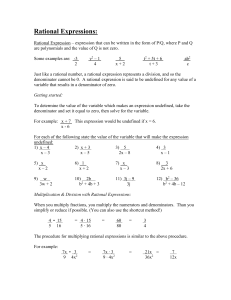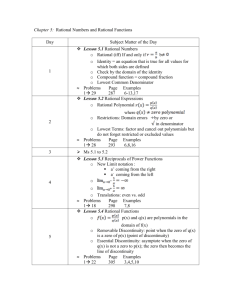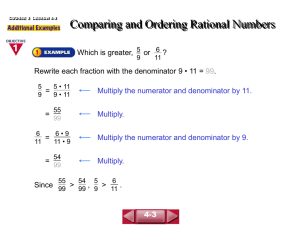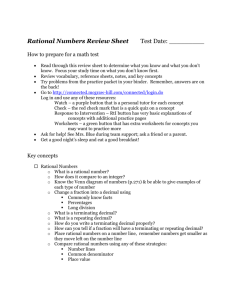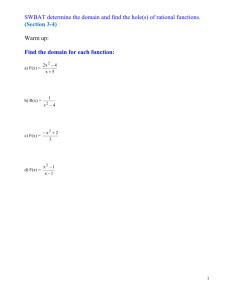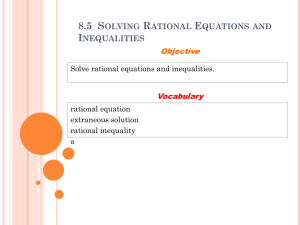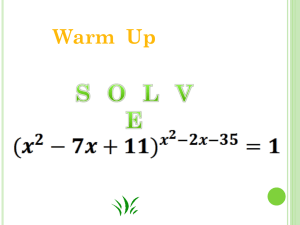Section 8.6 Study Guide
advertisement
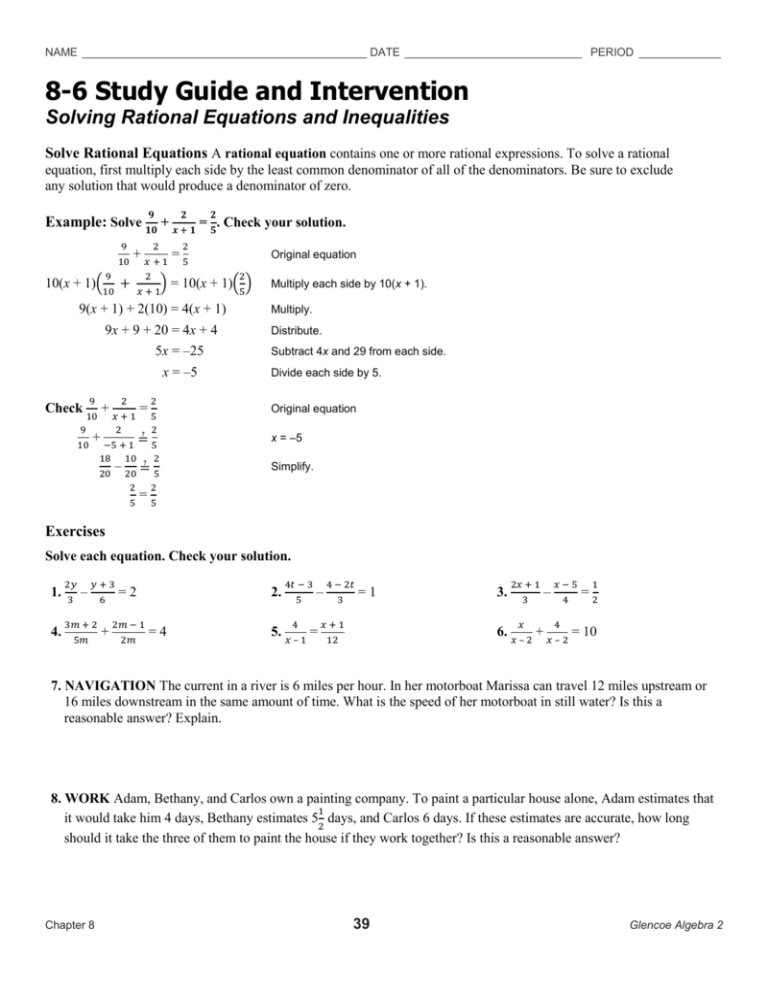
NAME _____________________________________________ DATE ____________________________ PERIOD _____________ 8-6 Study Guide and Intervention Solving Rational Equations and Inequalities Solve Rational Equations A rational equation contains one or more rational expressions. To solve a rational equation, first multiply each side by the least common denominator of all of the denominators. Be sure to exclude any solution that would produce a denominator of zero. 𝟗 𝟐 𝟐 Example: Solve 𝟏𝟎 + 𝒙 + 𝟏 = 𝟓. Check your solution. 9 10 9 10 10(x + 1)( 2 2 + 𝑥+1 = 5 + 2 ) 𝑥+1 9x + 9 + 20 = 4x + 4 5x = –25 x = –5 9 10 2 2 = 𝑥+1 5 9 2 2 + ≟ 10 −5 + 1 5 18 10 2 – ≟5 20 20 2 2 = 5 5 + 2 5 = 10(x + 1)( ) 9(x + 1) + 2(10) = 4(x + 1) Check Original equation Multiply each side by 10(x + 1). Multiply. Distribute. Subtract 4x and 29 from each side. Divide each side by 5. Original equation x = –5 Simplify. Exercises Solve each equation. Check your solution. 1. 2𝑦 3 4. 3𝑚 + 2 5𝑚 – 𝑦+3 6 + =2 2𝑚 − 1 2𝑚 =4 2. 4𝑡 − 3 5 5. 4 𝑥–1 – = 4 − 2𝑡 3 =1 𝑥+1 12 3. 2𝑥 + 1 3 – 6. 𝑥 𝑥–2 4 𝑥–2 + 𝑥−5 4 1 =2 = 10 7. NAVIGATION The current in a river is 6 miles per hour. In her motorboat Marissa can travel 12 miles upstream or 16 miles downstream in the same amount of time. What is the speed of her motorboat in still water? Is this a reasonable answer? Explain. 8. WORK Adam, Bethany, and Carlos own a painting company. To paint a particular house alone, Adam estimates that 1 it would take him 4 days, Bethany estimates 52 days, and Carlos 6 days. If these estimates are accurate, how long should it take the three of them to paint the house if they work together? Is this a reasonable answer? Chapter 8 39 Glencoe Algebra 2 NAME _____________________________________________ DATE ____________________________ PERIOD _____________ 8-6 Study Guide and Intervention (continued) Solving Rational Equations and Inequalities Solve Rational Inequalities To solve a rational inequality, complete the following steps. Step 1 State the excluded values. Step 2 Solve the related equation. Step 3 Use the values from steps 1 and 2 to divide the number line into regions. Test a value in each region to see which regions satisfy the original inequality. 𝟐 𝟒 𝟐 Example: Solve 𝟑𝒏 + 𝟓𝒏 ≤ 𝟑. Step 1 The value of 0 is excluded since this value would result in a denominator of 0. Step 2 Solve the related equation. 2 3𝑛 2 4 2 + 5𝑛 = 3 15n(3𝑛 + 4 ) 5𝑛 Related equation 2 = 15n(3) 10 + 12 = 10n 22 = 10n 2.2 = n Multiply each side by 15n. Simplify. Add. Divide each side by 10. Step 3 Draw a number with vertical lines at the excluded value and the solution to the equation. Test n = –1. 2 4 2 – 3 + (− 5) ≤ 3 is true. Test n = 1. Test n = 3. 2 3 2 9 4 2 + 5 ≤ 3 is not true. 4 2 + 15 ≤ 3 is true. The solution is n < 0 or n ≥ 2.2. Exercises Solve each inequality. Check your solutions. 3 1 1. 𝑎 + 1 ≥ 3 3 2 1 4. 2𝑥 – 𝑥 > 4 Chapter 8 1 2. 𝑥 ≥ 4x 4 4 2 3. 2𝑝 + 5𝑝 > 3 5 3 5. 𝑥 − 1 + 𝑥 < 2 2 6. 𝑥 2 − 1 + 1 > 𝑥 − 1 40 Glencoe Algebra 2

